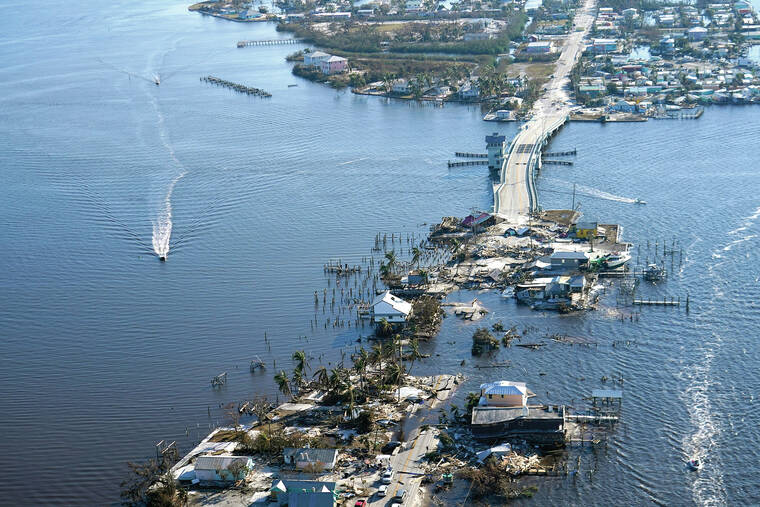Ian leaves dozens dead as focus turns to rescue, recovery
FORT MYERS, Fla. — Dozens of Florida residents left their flooded and splintered homes by boat and by air on Saturday as rescuers continued to search for survivors in the wake of Hurricane Ian, while authorities in South Carolina and North Carolina began taking stock of their losses.
The death toll from the storm, one of the strongest hurricanes by wind speed to ever hit the U.S., grew to nearly three dozen, with deaths reported from Cuba, Florida and North Carolina. The storm weakened Saturday as it rolled into the mid-Atlantic, but not before it washed out bridges and piers, hurdled massive boats into buildings onshore and sheared roofs off homes, leaving hundreds of thousands without power.
ADVERTISING
At least 35 people were confirmed dead, including 28 people in Florida mostly from drowning but others from Ian’s tragic aftereffects. An elderly couple died after their oxygen machines shut off when they lost power, authorities said.
As of Saturday, more than 1,000 people had been rescued from flooded areas along Florida’s southwestern coast alone, Daniel Hokanson, a four-star general and head of the National Guard, told The Associated Press while airborne to Florida.
Chris Schnapp was at the Port Sanibel Marina in Fort Myers on Saturday, waiting to see whether her 83-year-old mother-in-law had been evacuated from Sanibel Island. A pontoon boat had just arrived with a load of passengers from the island — with suitcases and animals in tow — but Schnapp’s mother-in-law was not among them.
“She stayed on the island. My brother-in-law and sister-in-law own two businesses over there. They evacuated. She did not want to go,” Schnapp said. Now, she said, she wasn’t sure if her mother-in-law was still on the island or had been taken to a shelter somewhere.
On Pine Island, the largest barrier island off Florida’s Gulf Coast, houses were reduced to splinters and boats littered roadways as a volunteer rescue group went door-to-door Saturday, asking isolated residents if they wanted to be evacuated. Residents described the horror of being trapped in their homes as water kept rising.
“The water just kept pounding the house and we watched, boats, houses — we watched everything just go flying by,” said Joe Conforti, as he fought back tears. He said if it wasn’t for his wife, who suggested they get up on a table to avoid the rising water, he wouldn’t have made it: “I started to lose sensibility, because when the water’s at your door and it’s splashing on the door and you’re seeing how fast it’s moving, there’s no way you’re going to survive that.”
River flooding posed a major challenge at times to rescue and supply delivery efforts. The Myakka River washed over a stretch of Interstate 75, forcing a traffic-snarling highway closure for a while Saturday. That’s a key corridor linking Tampa to the north with the hard-hit southwest Florida region that straddles Port Charlotte and Fort Myers. Later Saturday, state officials said, water levels had receded enough that I-75 could be fully reopened.
While rising waters in Florida’s southwest rivers have crested or are near cresting, the levels aren’t expected to drop significantly for days, said National Weather Service meteorologist Tyler Fleming in Tampa.
Elsewhere, South Carolina’s Pawleys Island — a beach community roughly 75 miles (115 kilometers) up the coast from Charleston — was among the places hardest hit. Power remained knocked out to at least half of the island Saturday.
Eddie Wilder, who has been coming to Pawleys Island for more than six decades, said Friday’s storm was “insane.” He said waves as high as 25 feet (7.6 meters) washed away the local pier — an iconic landmark.
“We watched it hit the pier and saw the pier disappear,” said Wilder, whose house 30 feet (9 meters) above the ocean stayed dry inside. “We watched it crumble and and watched it float by with an American flag.”
The Pawleys pier was one of at least four along South Carolina’s coast destroyed by battering winds and rain. Meanwhile, the intracoastal waterway was strewn with the remnants of several boat houses knocked off their pilings.
John Joseph, whose father built the family’s beige beach house in 1962, said Saturday he was elated to return from Georgetown — which took a direct hit.
He found his Pawleys Island home entirely intact.
“Thank God these walls are still here, and we feel very blessed that this is the worst thing,” he said of sand that had swept under his home. “What happened in Florida — gosh, God bless us. If we’d had a Category 4, I wouldn’t be here.”
In North Carolina, the storm claimed four lives and mostly downed trees and power lines, leaving over 280,000 people statewide without power at one point Saturday morning, officials said.


